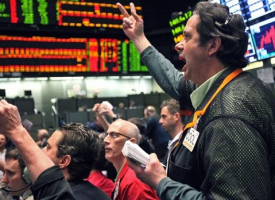As we near the end of summer, this development is going to have a massively bullish impact on the silver market.
Industrial Metals Breakout!
By Sam Broom, Sprott USA
August 24 (King World News) – Industrial Commodities Threaten Decade-Long Downtrend!
* Base metals are showing signs of real strength, with prices across the complex breaking out, or threatening to do so.
* Copper and zinc have looked the strongest of the bunch and both have recently broke out of multi-month consolidation patterns.
* The moves we are seeing have the hallmarks of a supply (destruction) driven rally, which tend to be sharp and ferocious in nature.
* An industry-wide decline in reserve quantity (depletion) and quality (grade), accompanied with a complete lack of new discoveries means we believe we’re likely to see an increase in M&A as prices begin to rise, which is why we’re interested in quality exploration and development stage plays.
Every now and then you get a feeling that the market is sending a message. Last week was one of those weeks as we witnessed a whole host of commodities either breaking out of multi-month consolidation patterns, or seriously threatening to do so.
The topside moves were generally spread across the commodity complex, but by far the most significant moves were seen in the base metals where we witnessed breakouts across the board, some in rather spectacular fashion.
From a higher level, this is best shown in a chart of the Bloomberg Industrial Metal Index, which has now broken out above a down trend that has been in place since the index peaked way back in 2007, over a decade ago.

When we dive into the individual metals, the recent top performers have undeniably been zinc (+ lead) and copper, both breaking out of multi-month consolidation patterns over the last few weeks to new multi-year highs…
IMPORTANT:
To hear which legend just spoke with KWN about $8,000 gold and the coming mania in the
gold, silver, and mining shares markets CLICK HERE OR ON THE IMAGE BELOW.
 Sponsored
Sponsored
This is not surprising to us given the strong fundamental drivers we see impacting the industry (largely supply side) and the moves we are seeing have all the hallmarks of one of Rick Rule’s favorite sayings playing out in reality – “Bear markets are always the authors of bull markets”.
That is because we are finally seeing signs of real supply destruction as a result of the brutal five to ten year bear market we’ve experienced in the commodity complex. Crucially for investors, it appears as though this is also starting to have an impact on commodity prices.
So, let’s take a closer look at two of the more dramatic movers – zinc and copper.
Zinc:
Zinc in particular has looked extremely strong and you can clearly see the week’s breakout on the chart below. The metal most commonly used as a galvanizing agent now appears to have successfully consolidated its 2016 run, which saw it claim the status of the best performing metal last year (with the exception of iron ore).
As of its close on Friday, the zinc price is up 115% from its January 2016 low of $1,440/t.

Zinc’s run has all the hallmarks of a supply (or lack thereof) driven move, which tend to be swift and devoid of major pullbacks or periods of choppiness.
This is supported by the hard data, which shows that since 2012, we’ve seen over 1 million tonnes (Mt) of shuttered production in a 13Mt market*1. Glencore alone (the world’s largest zinc producer) cut its zinc production by 24% in 2016, a year which also saw the closing of two of the world’s major zinc mines in Century (Australia) and Lisheen (Ireland).
We have been hearing of potential tightness in the zinc market for a while now, only to see “hidden” supply (likely of Chinese origin) dumped on the market whenever prices rallied.
However, this dynamic seems to have completely changed and Chinese figures now show the country is dealing with a significant mined deficit caused by declining production from the countries domestic mines.
Last week’s news that the Chinese government ordered a shutdown of all the lead and zinc mines in the Hunan province’s Huayuan county (a major zinc producing region) suggests that the countries zinc deficit is only likely to grow in the near to mid-term, further adding to the already strong tailwinds currently affecting the zinc price.
Copper:
Whilst not quite as spectacular as zinc, copper has shown signs of a real resurgence in 2017. The move started late in 2016 after the copper price ground out a text book basing pattern throughout the first three quarters of the year before breaking out proper in November.
2017 saw those gains consolidated as price traded in a sideways range before leading the base metals complex in breaking out topside a few weeks ago back in late July. Price is currently testing the key $3/lb level, as shown in the chart below.

As with most commodities we follow, we believe the most reliable drivers of the copper price into the foreseeable future are going to come primarily from the supply side of the equation. This is because we know that the industry is mining well above its reserve grade, meaning that over time the industry average mined grade is almost certain to decline.
Lower mined grades mean miners will have to increase the volume of ore they process every year, just to “tread water”. It also means we’re likely to see a climbing industry wide average cost of production (less copper produced per ton of ore mined/processed), increasingly rendering mines at the higher end of the cost curve uneconomic unless the copper price rises enough to compensate for the declining grades.
A text book example of this phenomenon can be seen at the Escondida mine in Chile, currently the largest copper mine in the world, producing over 5% of global annual supply.
The Escondida mine is currently mining ore that grades around 1% Cu, which is 1.4 x the life-of-mine reserve grade of its sulfide ore body, which currently sits just under 0.6% Cu. In other words, the mine is being “high graded”, meaning simple mathematics dictates that mine grades are set to steadily decline into the future.
This phenomenon is clearly visible in BHP’s (57.5% owner) 2016 operational update which highlighted a huge 28% year-on-year decline in mined grade during the year. Whilst part of the decline was due to grade variability within the ore body, it highlights a trend of a declining grade profile that’s only going to worsen over time.

This problem is by no means limited to Escondida, but rather is pervasive across the entire copper sector. With the world’s copper mines not only rapidly depleting in absolute terms (depletion), but also falling in quality by way of grade decline (result of high grading), we believe we’re likely to see significant downward pressure on the amount of the copper the industry is able to produce.
Completely ignoring the demand side of the equation (which is harder to quantify, but we are generally bullish on – think the increasing push towards electrification), an industry wide flat to declining production profile is usually a key ingredient in the recipe for higher prices.
To compound matters, low copper prices have all but killed the copper exploration sector, both at a brown fields (near existing mines) and green fields (new discoveries) level. The result, with a couple of notable exceptions, is that there is almost nothing in the way of new world-class copper projects ready to replace depletion from existing stock of copper mines.
This is why we are paying particular attention to exciting exploration projects, new copper discoveries and the few existing high-quality development plays which we believe are becoming increasingly attractive acquisition targets as the copper market turns and producer are forced to look at options to replace their rapidly depleting reserves.
Elsewhere in the base metals complex – nickel and cobalt look interesting
I wanted the focus of this article to be on zinc and copper, however it’s important to note there have been equally as important moves elsewhere in the sector, particularly in the metals that are leveraged to the rapidly growing lithium ion (Li-ion) battery sector like nickel and cobalt.
Nickel:
For example nickel, has been slowly but surely attempting to grind out a base over the past 18 months. This is shown on the chart below with the June/July low potentially forming the first major “lower high” since way back in 2011.

Nickel prices peaked at almost $54,000/t back in 2007. This means that at the current price of just under $11,000/t, the key ingredient in stainless steel is still down almost 80% from its peak seen over a decade ago, making it probably the single most contrarian metal within the base metals complex.
Nickel prices have shown a recent bout of strength, moving higher over the past few months and are now threatening to break out above the 2016 highs of $12,000/t – a key level to watch.
At face value, the fundamentals driving the sector look less favorable than the likes of zinc or copper (near record high warehouse inventory levels being key). However, there are enough green shoots out there to suggest it’s a metal that’s at least worthy of adding to your watch list.
One of the key drivers to watch is the growth of the electric vehicle and Li-ion battery industry, where nickel is a key (and becoming increasingly important) ingredient in most battery chemistries.
It’s difficult to predict the growth of the Li-ion sector (an industry prone to hyperbole), however the demand it is generating looks to be already having an impact, with nickel inventories declining for the first time in half a decade in 2015/16 in a world of flat to slightly increasing global mine production.
Whilst it’s far from a perfect indicator, I am also keeping a close eye on warehouse inventory levels as I believe an increase in the rate-of-decline will be a key “tell-tale” that the supply/demand balance is moving in favor of higher prices.
Should we see the continued strong growth in Li-ion uptake as the world moves towards electric vehicles, I believe there is potential for the nickel price to surprise a lot of people to the upside over the coming years.
Cobalt:
I’ve touched on cobalt a lot this year because it’s a metal with a very unique set of factors that affect its supply/demand balance, the key ones being:
* A tiny market size meaning it is prone to demand induced price shocks
* Supply that is dominated by production from one of the worlds least geopolitically unstable countries, the Democratic Republic of Congo (DRC)
* Demand that appears to be soaring thanks to cobalt being arguably the key input in most of the Li-ion battery chemistries that electric vehicles industry is moving towards.
Without going into the details (you can read my original write up from back in February here), the cobalt story is playing out largely as I expected with cobalt prices up over 140% from the 2016 lows.
The cobalt price has been consolidating in a relatively narrow range over the past 4 months, forming a bullish ascending triangle, a continuation pattern that often forms during strong up-trends.
Price is now threatening to breakout topside, as shown in the chart below by the weekly close at the high of its trading range.

Whilst technical patterns are never a guarantee of higher prices, a topside break over the coming few weeks would indicate continued buying pressure and would suggest the balance of probabilities has moved in favor of further price increases.
Lastly, we are moving towards the time of the year where the DRC political issues are likely to come to a head as the current president, Joseph Kabila, has promised that he will hold democratic elections by the end of 2017, something that now looks to be an almost impossibility.
Given the country is responsible for 60% to 65% of global mine production, there’s the potential for us to see a serious impact to global supply should we see material unrest in the country.
In other words, if you’re invested in the cobalt space, keep a very close eye on the DRC over the next four months.
Concluding comments:
Just as night becomes day, bear markets are always authors of an ensuing bull market and it appears as though this process is finally playing out in the base metals sector. This is seen by the stagnant-to-decreasing supply environment now present across many of the world’s key industrial metals.
This has started to cause sharp moves in metals such as zinc and copper, price action that is typically associated with rallies driven primarily by constrained supply.
Whilst there is no guarantee that this breakout will continue, after almost a decade of declines the recent strong price action suggests it’s time to (at the very least) pay close attention to the complex.
We favor companies at the exploration to development stage of the spectrum given we see reserve replacement being arguably the key issue for the sector moving forward.
However, given the prolonged bear market we’ve experienced, we see opportunities across the spectrum of explorers through to major miners.

King World News note: It is important to remember that silver is an industrial metal as well as a monetary metal. And Rick Rule has told KWN that the industrial metals are only in the 1st inning of a nine inning bull market. So silver will be set for some massive gains as the industrial metals bull market continues to surge. Silver will also be one of the primary beneficiaries of global financial and monetary instability because of its status as a monetary metal. Both of these factors will turbocharge silver’s price gains in coming years. If you have any questions or comments regarding the report above, please contact a Sprott representative at 800-477-7853.
***KWN has now released the remarkable audio interview with whistleblower and London metals trader Andrew Maguire discussing the US propaganda surrounding Fort Knox, an update on the upcoming 250 tonne physical order for gold and much more, and you can listen to it by CLICKING HERE OR ON THE IMAGE BELOW.
***ALSO JUST RELEASED: John Embry – Mnuchin Was Just Being Clever…All The Gold Is Not “Safe” In Fort Knox CLICK HERE.
 © 2017 by King World News®. All Rights Reserved. This material may not be published, broadcast, rewritten, or redistributed. However, linking directly to the articles is permitted and encouraged.
© 2017 by King World News®. All Rights Reserved. This material may not be published, broadcast, rewritten, or redistributed. However, linking directly to the articles is permitted and encouraged.







